+ Open data
Open data
- Basic information
Basic information
| Entry |  | |||||||||
|---|---|---|---|---|---|---|---|---|---|---|
| Title | Cryo-EM structure of LGR4-RSPO2-ZNRF3 complex (2:2:2) | |||||||||
 Map data Map data | ||||||||||
 Sample Sample |
| |||||||||
 Keywords Keywords | Wnt signal / MEMBRANE PROTEIN | |||||||||
| Function / homology |  Function and homology information Function and homology informationtrachea cartilage morphogenesis / negative regulation of odontogenesis of dentin-containing tooth / lung growth / regulation of Wnt signaling pathway, planar cell polarity pathway / Wnt receptor catabolic process / metanephric glomerulus development / metanephric nephron tubule morphogenesis / negative regulation of non-canonical Wnt signaling pathway / epithelial cell proliferation involved in renal tubule morphogenesis / protein-hormone receptor activity ...trachea cartilage morphogenesis / negative regulation of odontogenesis of dentin-containing tooth / lung growth / regulation of Wnt signaling pathway, planar cell polarity pathway / Wnt receptor catabolic process / metanephric glomerulus development / metanephric nephron tubule morphogenesis / negative regulation of non-canonical Wnt signaling pathway / epithelial cell proliferation involved in renal tubule morphogenesis / protein-hormone receptor activity / intestinal stem cell homeostasis / BMP receptor binding / negative regulation of toll-like receptor signaling pathway / positive regulation of branching involved in ureteric bud morphogenesis / male genitalia development / dopaminergic neuron differentiation / bone remodeling / frizzled binding / embryonic forelimb morphogenesis / digestive tract development / embryonic hindlimb morphogenesis / limb development / negative regulation of cold-induced thermogenesis / negative regulation of cytokine production / epithelial tube branching involved in lung morphogenesis / bone mineralization / hair follicle development / canonical Wnt signaling pathway / positive regulation of Wnt signaling pathway / Regulation of FZD by ubiquitination / stem cell proliferation / circadian regulation of gene expression / negative regulation of canonical Wnt signaling pathway / G protein-coupled receptor activity / RING-type E3 ubiquitin transferase / Wnt signaling pathway / ubiquitin-protein transferase activity / osteoblast differentiation / ubiquitin protein ligase activity / transmembrane signaling receptor activity / positive regulation of canonical Wnt signaling pathway / heparin binding / ubiquitin-dependent protein catabolic process / spermatogenesis / protein ubiquitination / signaling receptor binding / innate immune response / cell surface / extracellular space / extracellular region / zinc ion binding / plasma membrane Similarity search - Function | |||||||||
| Biological species |  Homo sapiens (human) Homo sapiens (human) | |||||||||
| Method | single particle reconstruction / cryo EM / Resolution: 3.59 Å | |||||||||
 Authors Authors | Peng Y / Fujimura A / Asami J / Zhang Z / Shimizu T / Ohto U | |||||||||
| Funding support |  Japan, 1 items Japan, 1 items
| |||||||||
 Citation Citation |  Journal: Nat Commun / Year: 2025 Journal: Nat Commun / Year: 2025Title: Structural insights into Wnt/β-catenin signaling regulation by LGR4, R-spondin, and ZNRF3. Authors: Yuxuan Peng / Akiko Fujimura / Jinta Asami / Zhikuan Zhang / Toshiyuki Shimizu / Umeharu Ohto /  Abstract: Leucine-rich repeat-containing G protein-coupled receptor 4 (LGR4) plays a critical role in regulating the wingless-related integration site (Wnt) signaling pathway and is essential for organ ...Leucine-rich repeat-containing G protein-coupled receptor 4 (LGR4) plays a critical role in regulating the wingless-related integration site (Wnt) signaling pathway and is essential for organ development and carcinogenesis. LGR4, along with its ligand R-spondin (RSPO), potentiates Wnt/β-catenin signaling by recruiting its signaling suppressor, E3 ligase Zinc and Ring Finger 3 (ZNRF3), and inducing its membrane clearance. However, detailed mechanisms underlying this process remain unknown. In this study, we present the cryo-electron microscopy structures of human LGR4, the LGR4-RSPO2 and LGR4-RSPO2-ZNRF3 complexes. Upon RSPO2 binding, LGR4 undergoes no significant conformational changes in its transmembrane and extracellular domain structures or their relative orientations. LGR4, RSPO2, and ZNRF3 assemble into a 2:2:2 complex with the ZNRF3 dimer enclosed at the center. This ternary arrangement and forced dimerization of ZNRF3 likely underpin how LGR4 and RSPO2 potentiate Wnt/β-catenin signaling by sequestering ZNRF3 from Wnt receptors and facilitating its auto-inactivation. This study provides a structural basis for understanding the regulatory mechanism of Wnt/β-catenin signaling through the LGR4-RSPO2-ZNRF3 pathway and may offer opportunities for future drug development targeting this axis. | |||||||||
| History |
|
- Structure visualization
Structure visualization
| Supplemental images |
|---|
- Downloads & links
Downloads & links
-EMDB archive
| Map data |  emd_62221.map.gz emd_62221.map.gz | 41.9 MB |  EMDB map data format EMDB map data format | |
|---|---|---|---|---|
| Header (meta data) |  emd-62221-v30.xml emd-62221-v30.xml emd-62221.xml emd-62221.xml | 17.5 KB 17.5 KB | Display Display |  EMDB header EMDB header |
| Images |  emd_62221.png emd_62221.png | 107.6 KB | ||
| Filedesc metadata |  emd-62221.cif.gz emd-62221.cif.gz | 6.3 KB | ||
| Others |  emd_62221_half_map_1.map.gz emd_62221_half_map_1.map.gz emd_62221_half_map_2.map.gz emd_62221_half_map_2.map.gz | 77.5 MB 77.5 MB | ||
| Archive directory |  http://ftp.pdbj.org/pub/emdb/structures/EMD-62221 http://ftp.pdbj.org/pub/emdb/structures/EMD-62221 ftp://ftp.pdbj.org/pub/emdb/structures/EMD-62221 ftp://ftp.pdbj.org/pub/emdb/structures/EMD-62221 | HTTPS FTP |
-Validation report
| Summary document |  emd_62221_validation.pdf.gz emd_62221_validation.pdf.gz | 824.4 KB | Display |  EMDB validaton report EMDB validaton report |
|---|---|---|---|---|
| Full document |  emd_62221_full_validation.pdf.gz emd_62221_full_validation.pdf.gz | 824 KB | Display | |
| Data in XML |  emd_62221_validation.xml.gz emd_62221_validation.xml.gz | 12.8 KB | Display | |
| Data in CIF |  emd_62221_validation.cif.gz emd_62221_validation.cif.gz | 15.2 KB | Display | |
| Arichive directory |  https://ftp.pdbj.org/pub/emdb/validation_reports/EMD-62221 https://ftp.pdbj.org/pub/emdb/validation_reports/EMD-62221 ftp://ftp.pdbj.org/pub/emdb/validation_reports/EMD-62221 ftp://ftp.pdbj.org/pub/emdb/validation_reports/EMD-62221 | HTTPS FTP |
-Related structure data
| Related structure data |  9kb9MC  9kb6C  9kb7C  9kb8C M: atomic model generated by this map C: citing same article ( |
|---|---|
| Similar structure data | Similarity search - Function & homology  F&H Search F&H Search |
- Links
Links
| EMDB pages |  EMDB (EBI/PDBe) / EMDB (EBI/PDBe) /  EMDataResource EMDataResource |
|---|---|
| Related items in Molecule of the Month |
- Map
Map
| File |  Download / File: emd_62221.map.gz / Format: CCP4 / Size: 83.7 MB / Type: IMAGE STORED AS FLOATING POINT NUMBER (4 BYTES) Download / File: emd_62221.map.gz / Format: CCP4 / Size: 83.7 MB / Type: IMAGE STORED AS FLOATING POINT NUMBER (4 BYTES) | ||||||||||||||||||||||||||||||||||||
|---|---|---|---|---|---|---|---|---|---|---|---|---|---|---|---|---|---|---|---|---|---|---|---|---|---|---|---|---|---|---|---|---|---|---|---|---|---|
| Projections & slices | Image control
Images are generated by Spider. | ||||||||||||||||||||||||||||||||||||
| Voxel size | X=Y=Z: 1.245 Å | ||||||||||||||||||||||||||||||||||||
| Density |
| ||||||||||||||||||||||||||||||||||||
| Symmetry | Space group: 1 | ||||||||||||||||||||||||||||||||||||
| Details | EMDB XML:
|
-Supplemental data
-Half map: #2
| File | emd_62221_half_map_1.map | ||||||||||||
|---|---|---|---|---|---|---|---|---|---|---|---|---|---|
| Projections & Slices |
| ||||||||||||
| Density Histograms |
-Half map: #1
| File | emd_62221_half_map_2.map | ||||||||||||
|---|---|---|---|---|---|---|---|---|---|---|---|---|---|
| Projections & Slices |
| ||||||||||||
| Density Histograms |
- Sample components
Sample components
-Entire : LGR4-RSPO2-ZNRF3 complex (2:2:2)
| Entire | Name: LGR4-RSPO2-ZNRF3 complex (2:2:2) |
|---|---|
| Components |
|
-Supramolecule #1: LGR4-RSPO2-ZNRF3 complex (2:2:2)
| Supramolecule | Name: LGR4-RSPO2-ZNRF3 complex (2:2:2) / type: complex / ID: 1 / Parent: 0 / Macromolecule list: #1-#3 |
|---|---|
| Source (natural) | Organism:  Homo sapiens (human) Homo sapiens (human) |
-Macromolecule #1: Leucine-rich repeat-containing G-protein coupled receptor 4
| Macromolecule | Name: Leucine-rich repeat-containing G-protein coupled receptor 4 type: protein_or_peptide / ID: 1 / Number of copies: 2 / Enantiomer: LEVO |
|---|---|
| Source (natural) | Organism:  Homo sapiens (human) Homo sapiens (human) |
| Molecular weight | Theoretical: 93.372047 KDa |
| Recombinant expression | Organism:  Homo sapiens (human) Homo sapiens (human) |
| Sequence | String: MPGPLGLLCF LALGLLGSAG PSGAAPPLCA APCSCDGDRR VDCSGKGLTA VPEGLSAFTQ ALDISMNNIT QLPEDAFKNF PFLEELQLA GNDLSFIHPK ALSGLKELKV LTLQNNQLKT VPSEAIRGLS ALQSLRLDAN HITSVPEDSF EGLVQLRHLW L DDNSLTEV ...String: MPGPLGLLCF LALGLLGSAG PSGAAPPLCA APCSCDGDRR VDCSGKGLTA VPEGLSAFTQ ALDISMNNIT QLPEDAFKNF PFLEELQLA GNDLSFIHPK ALSGLKELKV LTLQNNQLKT VPSEAIRGLS ALQSLRLDAN HITSVPEDSF EGLVQLRHLW L DDNSLTEV PVHPLSNLPT LQALTLALNK ISSIPDFAFT NLSSLVVLHL HNNKIRSLSQ HCFDGLDNLE TLDLNYNNLG EF PQAIKAL PSLKELGFHS NSISVIPDGA FDGNPLLRTI HLYDNPLSFV GNSAFHNLSD LHSLVIRGAS MVQQFPNLTG TVH LESLTL TGTKISSIPN NLCQEQKMLR TLDLSYNNIR DLPSFNGCHA LEEISLQRNQ IYQIKEGTFQ GLISLRILDL SRNL IHEIH SRAFATLGPI TNLDVSFNEL TSFPTEGLNG LNQLKLVGNF KLKEALAAKD FVNLRSLSVP YAYQCCAFWG CDSYA NLNT EDNSLQDHSV AQEKGTADAA NVTSTLENEE HSQIIIHCTP STGAFKPCEY LLGSWMIRLT VWFIFLVALF FNLLVI LTT FASCTSLPSS KLFIGLISVS NLFMGIYTGI LTFLDAVSWG RFAEFGIWWE TGSGCKVAGF LAVFSSESAI FLLMLAT VE RSLSAKDIMK NGKSNHLKQF RVAALLAFLG ATVAGCFPLF HRGEYSASPL CLPFPTGETP SLGFTVTLVL LNSLAFLL M AVIYTKLYCN LEKEDLSENS QSSMIKHVAW LIFTNCIFFC PVAFFSFAPL ITAISISPEI MKSVTLIFFP LPACLNPVL YVFFNPKFKE DWKLLKRRVT KKENLYFQGD YKDDDDKHHH HHHHH UniProtKB: Leucine-rich repeat-containing G-protein coupled receptor 4 |
-Macromolecule #2: E3 ubiquitin-protein ligase ZNRF3
| Macromolecule | Name: E3 ubiquitin-protein ligase ZNRF3 / type: protein_or_peptide / ID: 2 / Number of copies: 2 / Enantiomer: LEVO / EC number: RING-type E3 ubiquitin transferase |
|---|---|
| Source (natural) | Organism:  Homo sapiens (human) Homo sapiens (human) |
| Molecular weight | Theoretical: 25.888084 KDa |
| Recombinant expression | Organism:  Homo sapiens (human) Homo sapiens (human) |
| Sequence | String: METGLRWLLL VAVLKGVQCK ETAFVEVVLF ESSPSGDYTT YTTGLTGRFS RAGATLSAEG EIVQMHPLGL CNNNDEEDLY EYGWVGVVK LEQPELDPKP CLTVLGKAKR AVQRGATAVI FDVSENPEAI DQLNQGSEDP LKRPVVYVKG ADAIKLMNIV N KQKVARAR ...String: METGLRWLLL VAVLKGVQCK ETAFVEVVLF ESSPSGDYTT YTTGLTGRFS RAGATLSAEG EIVQMHPLGL CNNNDEEDLY EYGWVGVVK LEQPELDPKP CLTVLGKAKR AVQRGATAVI FDVSENPEAI DQLNQGSEDP LKRPVVYVKG ADAIKLMNIV N KQKVARAR IQHRPPRQPT EYFDMGIFLA FFVVVSLVCL ILLVKIKLKQ RRSQNSMNRL AVQALEKMET RKF UniProtKB: E3 ubiquitin-protein ligase ZNRF3 |
-Macromolecule #3: R-spondin-2
| Macromolecule | Name: R-spondin-2 / type: protein_or_peptide / ID: 3 / Number of copies: 2 / Enantiomer: LEVO |
|---|---|
| Source (natural) | Organism:  Homo sapiens (human) Homo sapiens (human) |
| Molecular weight | Theoretical: 18.953715 KDa |
| Recombinant expression | Organism:  Homo sapiens (human) Homo sapiens (human) |
| Sequence | String: MQFRLFSFAL IILNCMDYSH CQGNRWRRSK RASYVSNPIC KGCLSCSKDN GCSRCQQKLF FFLRREGMRQ YGECLHSCPS GYYGHRAPD MNRCARCRIE NCDSCFSKDF CTKCKVGFYL HRGRCFDECP DGFAPLEETM ECVEENLYFQ GHHHHHHHHH H UniProtKB: R-spondin-2 |
-Macromolecule #4: 2-acetamido-2-deoxy-beta-D-glucopyranose
| Macromolecule | Name: 2-acetamido-2-deoxy-beta-D-glucopyranose / type: ligand / ID: 4 / Number of copies: 4 / Formula: NAG |
|---|---|
| Molecular weight | Theoretical: 221.208 Da |
| Chemical component information | 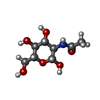 ChemComp-NAG: |
-Experimental details
-Structure determination
| Method | cryo EM |
|---|---|
 Processing Processing | single particle reconstruction |
| Aggregation state | particle |
- Sample preparation
Sample preparation
| Buffer | pH: 7.5 |
|---|---|
| Vitrification | Cryogen name: ETHANE |
- Electron microscopy
Electron microscopy
| Microscope | TFS KRIOS |
|---|---|
| Image recording | Film or detector model: GATAN K3 (6k x 4k) / Average electron dose: 48.0 e/Å2 |
| Electron beam | Acceleration voltage: 300 kV / Electron source:  FIELD EMISSION GUN FIELD EMISSION GUN |
| Electron optics | Illumination mode: FLOOD BEAM / Imaging mode: BRIGHT FIELD / Nominal defocus max: 2.0 µm / Nominal defocus min: 1.0 µm |
| Experimental equipment |  Model: Titan Krios / Image courtesy: FEI Company |
 Movie
Movie Controller
Controller








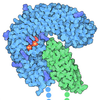

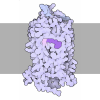
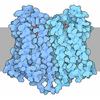



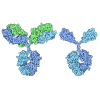






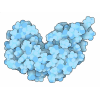
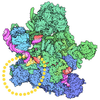

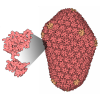

 Z (Sec.)
Z (Sec.) Y (Row.)
Y (Row.) X (Col.)
X (Col.)




































